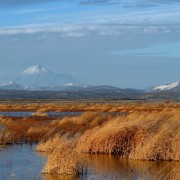Camels May Store Answers for Thirsty Africa

Camel farming may become a central focus in the arid and semi-arid regions of Africa as climate change tightens its grip on agriculture. The drought-resistant animals can become an attractive alternative for farmers, who could struggle to grow crops as hotter conditions and less rainfall are expected to hit vast areas of Africa, a new report by the International Livestock Research Institute and Waen Associates said.
The Croppers to livestock keepers: livelihood transitions to 2050 in Africa due to Climate Change study, which was released earlier this month, predicts that by 2050 climate change will affect between 500,000 and 1 million square kilometers of marginal farmland in Africa. But it also suggests that growing hardier types of livestock, such as camels, donkeys, goats and cattle, could be the answer to the agricultural challenges of the near future.
“Livestock, particularly animals that are known to be tolerant of heat and drought, can survive in conditions that are far more severe than what crops can tolerate,” said Philip Thornton, co-author of the report. “Livestock can provide poor household with a buffer against the risk of climate change and allow them to take advantage of the increasing demand for animal products in Africa.”
Camels, which are especially adapted for dry desert areas, can be used for their milk, meat, hair and as traditional means of transport. Their milk is mostly traded informally, but the United Nation’s Food and Agriculture Organization (FAO) predicts it could become a world market worth $10 billion. FAO also estimates that there are some 20 million camels globally.
The milk, slightly saltier than cow’s, is also three times as rich in Vitamin C. It contains significant amounts of iron, unsaturated fatty acids and B vitamins.
While healthier, camel production can also be more sustainable. Camels, sometimes called the “ships of the desert,” can go five to seven days without drinking and can tolerate water from sources that are too brackish for cattle. This makes them an excellent option for rethinking and planning for the agricultural systems of the future, the report said.
According to Thornton, farming communities in the affected areas should take the lead from many of Africa’s pastoralist communities who have been adapting to variable climate conditions for many generations. For example, communities like the Samburu tribe in Northern Kenya, who are traditionally cattle farmers, already keep camels because of disease-causing drought and cattle raids from other tribes.
Read more here, here and here.
Sources: UN Integrated Regional Information Network (IRIN), Environmental Science and Policy, UN Food and Agriculture Organization (FAO), International Livestock Research Institute
Connor Bebb assists in daily operations, aids in research, oversees social media outlets and develops social media strategies at Circle of Blue.







Leave a Reply
Want to join the discussion?Feel free to contribute!